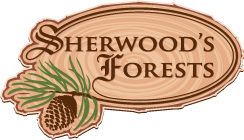Mulching -- War Against the Weeds
When trying to get a small tree to turn into a big tree rather than a small dead stick, it's important to give it every chance you can. Weeds compete for water, nutrients and, when the tree is really small, light.
A mulching system also has the advantage that the tree is easier to spot.
This can be very important if other people in your family are equipped with
riding lawn mowers.
Mulches fall into three categories: Plastic, fabric and organic debris. All of them have two goals: Help the tree get water, and keep the weeds from being pigs. (And in this context, grass is a weed...)
Plastic mulch. Usually black, although there are special colours to promote this and that. Construction grade black plastic will last a season. The ultra-violet in sunlight breaks the plastic down. After a summer of sun tends to turn into black confetti. For not a whole lot more money, but with a whole lot more aggravation to find, you can get horticultural grade plastic which has a UV inhibitor in it. I have two shelterbelts done 3 years ago with 6 mil (6 thousands of an inch) black plastic. It's showing it's age, not from the sun, but from moose and deer hooves, and the occasional ravage of a mower brought too close.
Plastic mulch is almost totally impervious to weeds, but it's also impervious to air. Ok for doing strips, as in shelterbelts. Not good for large areas.
Fabric Mulches. Landscape cloth comes in varying weights and quality grades. In essence a fine weave burlap made of synthetic material. It breathes, lets water throuh. Most grades will keep seeds from sending down roots from teh top but aren't so good at keeping nice solid roots from pushing a sprout through from the bottom. You have to be more thorough with your prep.
I've been experimenting with using old carpet as a mulch. So far it works very well. There are two ways to apply it. If the tree is really small, I will take as square of carpet between 2.5 and 3 feet on a side, and cut a 6" X in the fabric. I'll then cut a corner off one of the bits where the cuts cross to leave room for the trunk. Putting them down is best done with a helper. One person grabs the tree, holding all of its branches together, while the other person slides the slit over the tree. Good family time.
The second method works when the trees are larger, or the rest of your family has abandoned you, leaving you alone while they mutter about druids, and passing mention of Yggdrasil. Take two chunks of carpet, each 2x3 feet. Cut a notch an inch wide and 8" deep into the edge of one piece. lay it down. Put the other piece so it overlaps the notch.
In either case the wind has a nasty habit of moving your magic carpet mulch. (Or is it because it's magic carpet...) I've used rocks, nails and geotextile staples to fasten them down. Rocks are cheap, but they get bumped by the lawnmower. Then the corners curl up. Then the next mower rips the carpet off the tree, and puts carpet confetti all over the lawn. Been there. Done that.
Nails work quite well. 5" spiral spikes are great. Expensive if you are doing a lot of trees this way.
Geotextile staples are basically a foot of coat hanger wire bent into a U. Hold firmly on the carpet, and wallop the end with a hammer, or if your aim is shaky, a hunk of 2x4.
The final category is organic stuff. Leaves work well. I've taken the truck and trailer into town on a fall day, and have driven up and down the alleys grabbing bags of leaves destined for the trash. The downside: I've gotten some interesting weed seeds this way.
Grass clippings work well, if you don't apply too many at once. The slugs love it when the bottom of a pile of grass turns to slime. Once the seedling actually has some bark, it doesn't matter. Slugs aren't big on climbing rough bark. I guess it hurts their little what? feet?
Straw also works. If you are using for shelterbelts, or other windy place, get baled straw. It separates into books and flakes that don't blow around easily.
I use straw on my potted trees. Apply about an inch thick layer, and leave a small bundle near by for filling in holes caused by dogs and small children.
Flax sheerlings are the ultimate organic mulch. Basically flax straw that has been run through a forage mill or a mower after it's partially dried. The stuff is fuzzy from the linen fibres. Apply in loose handfuls, when it's rained on, it mats together like felt, and short of a cloudburst, will stay put until it rots. Just try to find flax straw around Edmonton.
Got something to say? Email me: sfinfo@sherwoods-forests.com
Interesting? Share this page.
Want to talk right now? Call me: (8 am to 8 pm only, please) 1-780-848-2548
Do not arrive unannounced. Phone for an appointment. Why? See Contact & Hours That same page gives our hours of operation.
Back to Top
Copyright © 2008 - 2021 S. G. Botsford
Sherwood's Forests is located about 75 km southwest of Edmonton, Alberta. Please refer to the map on our Contact page for directions.
